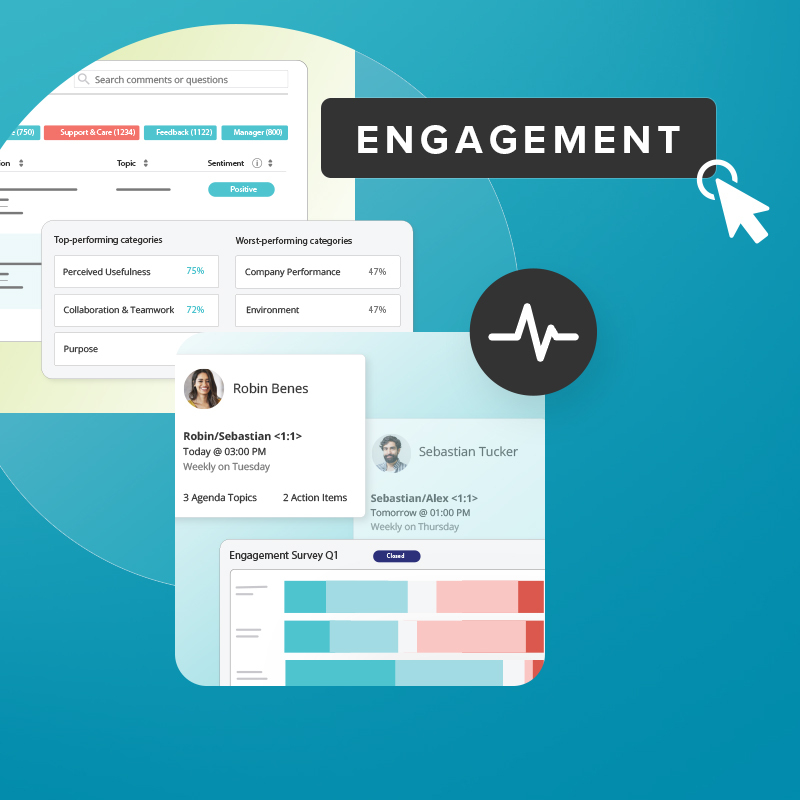Employee feedback is the key driver of modern performance management. But giving feedback at work has been subject to countless misconceptions and misleading advice. Don’t let myths about feedback in the workplace hold you back from delivering the high-quality feedback your team members need to reach their performance potential.
Don’t fall for these common myths about feedback.
Myth No. 1: Feedback Can Only Be Positive or Negative
You may only know about two categories of feedback: positive feedback and negative feedback. But “positive” and “negative” typically refer to the emotional reaction that managers expect employees to have, not the feedback itself. Focusing on the reaction — rather than future actions — can color how feedback is delivered and received.
4 Types of Feedback
There are four types of feedback you can deliver to employees. Understanding the different types of feedback will help you determine which is most effective for your team. The first three types of feedback come from the manager rather than the employee.
- Directive feedback proposes specific actions for the team member to take to improve their performance.
- Contingency feedback offers an evaluation or consequence based on a specific action. It may praise actions taken or suggest a new course of action to change an outcome.
- Attribution feedback delivers feedback in terms of qualities, and it may assign a label to the employee (such as saying, “you’re productive”).
- Impact feedback focuses on the outcomes of the employee’s actions on their team members and colleagues, prompting people to evaluate their own performance.
Of these, impact feedback tends to be most effective because it explains why the employee’s actions matter, helping them act more thoughtfully or strategically in the future.
Myth No. 2: Employees Don’t Want to Hear Negative Feedback
Managers may assume that employees don’t want feedback they perceive as negative. But employees crave feedback that can help them understand and improve their work. As long as critical feedback is framed appropriately and doesn’t dwell on mistakes, employees typically won’t shut down or react negatively to it.
How to Deliver Constructive Criticism
When offering constructive criticism, bring empathy to the conversation — don’t assume that mistakes are the result of ill will or laziness. Let the employee know that you understand why they took the course of action they did. If you don’t understand where they’re coming from, ask them and try to understand their thought process.
But don’t dwell on the past for long: Acknowledge the past only as it relates to future performance.
Myth No. 3: Good Feedback Requires Exhaustive Detail
Managers may feel the need to overexplain when an employee makes a mistake, but that can make the feedback process more complicated and confusing than it needs to be. This approach can also make the employee feel as though they’re being punished, which may cause them to shut down rather than engage and change their behavior.
3 Keys to an Effective Feedback Session
Effective feedback should be clear and concise. Use the situation-behavior-impact model to home in on what’s most important.
- The situation refers to the context of when and where the behavior occurred.
- The behavior is the specific action you want to address.
- The impact is the “why” of addressing it, naming the effects their action had on the team and the business.
Don’t simply chastise an employee for something in the past. Make the feedback mean something by helping them understand how to avoid such mistakes in the future.
Finally, make sure your feedback is timely. If you offer feedback immediately after the action occurs, you won’t have to remind the employee about the incident. You can simply address the behavior and move on.
Myth No. 4: You Have to Deliver Feedback in a Specific Time and Place
Traditionally, feedback has been exchanged during a one-on-one performance evaluation, but feedback doesn’t have to be restricted to such interactions.
In fact, limiting feedback to a performance review often puts too much time between the action and when it’s addressed, limiting the impact your feedback can have. Since the problem wasn’t addressed right away, employees might assume that it wasn’t a critical error. Or they might believe you’re simply looking for something negative to say during the review. If the feedback is positive but delayed, on the other hand, the employee might believe that you don’t appreciate their contributions.
Additionally, offering feedback only once or twice a year turns it into an event, and that can cause employees to feel anxious or defensive going into the meeting.
Constructive Feedback in the Flow of Work
Offering feedback in the flow of work helps you address behaviors in real time. Employees will make a better connection between what you’re telling them and how they can improve moving forward. Feedback that occurs in real time comes across as more genuine and prevents surprises for employees when formal evaluations do occur.
Myth No. 5: Only Managers Can Offer Feedback
Managers may assume that feedback flows in one direction: from them to the employee. But the most effective feedback accounts for several parties and moves in both directions.
Colleagues can provide effective feedback to their peers, too, and it may even resonate more coming from people working the same role or at the same level. Team members can provide useful, actionable feedback to their managers and other leaders to help them better support the team. Self-evaluation is an important part of the equation, too.
Implement 360-Degree Performance Reviews
This feedback model accounts for all perspectives, driving home the impact of each employee’s behaviors. 360-degree feedback helps employees become more thoughtful about their own actions and how others can help them drive business results.
This type of feedback also reinforces each employee’s sense of purpose and connection to their colleagues and their work. Engage every member of the team in feedback to produce the best results.
Don’t let myths about feedback stop you from helping your team reach their performance goals. Learn more about how feedback practices can impact employee experience and engagement in our latest Global HR Research report, The State of Performance Enablement.


